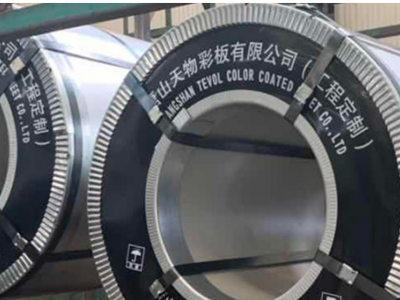天物彩板专注彩板行业16年——兴福镇彩涂卷厂家_镀锌钢板价格表请拨打网站上方电话咨询

铁是钢的主要成分。碳含量低于2.11%的铁碳合金称为钢。但工业碳钢除碳外还有其它元素,如硅、锰、磷、硫等,这些元素分为脱氧元素(如硅、锰等)、杂质元素(如熔炼未变质的磷、硫等)和合金元素(如钼、铬、稀土等),为提高性能而添加的等)。
(1) 碳冲击碳是决定碳钢缓冷后组织和性能的主要元素。一般来说,碳含量增加,强度增加,延伸率降低。此外,不同组织(铁素体、渗碳体和珠光体)的性能也有明显差异。随着碳含量的增加,碳钢的耐蚀性降低,焊接性和冷加工性(冲压和拉伸)也降低。
(2) 锰对碳钢中锰含量的影响一般为0.25%~0.80%。在高锰含量的碳钢中,锰的含量可达到1.2%。在碳钢中,锰是一种有益的元素。对于镇静钢来说,锰可以提高硅和铝的脱氧效果,也可以与硫结合形成硫化锰,从而在很大程度上消除钢中硫的有害影响。锰对碳钢的力学性能有很好的影响。它能提高热轧后钢的硬度和强度。当锰含量不高时,碳钢的表面收缩率和冲击韧性可略有提高或不降低。
(3) 碳素钢中硅含量的影响小于或等于0.5%。硅也是钢中一种有用的元素。沸腾钢中的硅含量很低。硅作为脱氧元素添加到镇静钢中。硅增加了钢液的流动性。除了形成非金属夹杂物外,硅还可溶于铁素体。但当硅含量超过一定值时,材料的冲击韧性明显降低。
(4) 硫的影响一般来说,硫是一种有害元素,主要来源于生铁。硫的危害是钢在热加工过程中的开裂,即所谓的热脆性是由硫的严重偏析引起的。即使硫含量不是很高,也会有(Fe+FES)共晶。一般来说,加入锰是为了防止热脆性。硫通过形成硫化物夹杂影响钢的力学性能。硫对钢的力学性能的影响不仅与夹杂物的含量有关,还与夹杂物的大小、形状和结构有关。
(5) 磷的影响一般来说,磷是一种有害的杂质元素,它来源于炼钢原料如矿石和生铁。磷在纯铁中有相当大的溶解度。磷能提高钢的强度,但钢的韧性降低,特别是钢的脆性转变温度急剧升高,即提高钢的冷脆性。在低碳钢中,磷对冷脆化的危害较小。在这种情况下,磷可以用来提高钢的强度。此外,磷还可以提高热轧板的耐大气腐蚀性能,降低其附着力。
Iron is the main component of steel. Iron carbon alloy with carbon content less than 2.11% is called steel. But industrial carbon steel has other elements besides carbon, such as silicon, manganese, phosphorus, sulfur, etc. these elements are divided into deoxidizing elements (such as silicon, manganese, etc.), impurity elements (such as smelting the undeleted phosphorus, sulfur, etc.) and alloy elements (such as molybdenum, chromium, rare earth, etc. added to improve performance). (1) Carbon impact Carbon is the main element that determines the structure and properties of carbon steel after slow cooling. In general, the carbon content increases, the strength increases and the elongation decreases. In addition, the properties of different structures (ferrite, cementite and pearlite) are obviously different. With the increase of carbon content, the corrosion resistance of carbon steel is decreased, and the weldability and cold workability (stamping and drawing) of carbon steel are also decreased. (2) The effect of manganese The content of manganese in carbon steel is generally 0.25% ~ 0.80%. In carbon steel with high manganese content, the content of manganese can reach 1.2%. In carbon steel, manganese is a beneficial element. For killed steel, manganese can improve the deoxidization effect of silicon and aluminum, and can also combine with sulfur to form manganese sulfide, so as to eliminate the harmful effect of sulfur in steel to a large extent. Manganese has a good effect on the mechanical properties of carbon steel. It can improve the hardness and strength of the steel after hot rolling. When the manganese content is not high, the surface shrinkage and impact toughness of carbon steel can be slightly increased or not reduced. (3) Influence of silicon Silicon content in carbon steel is less than or equal to 0.5%. Silicon is also a useful element in steel. In the boiling steel, the silicon content is very low. Silicon is added to the killed steel as a deoxidizing element. Silicon increases the fluidity of liquid steel. In addition to forming non-metallic inclusions, silicon is soluble in ferrite. However, when the silicon content exceeds a certain value, the impact toughness of the material decreases significantly. (4) Effect of sulfur Generally speaking, sulfur is a harmful element, which mainly comes from pig iron. The harm of sulfur is the cracking of steel during hot working, that is to say, the so-called hot brittleness is caused by the serious segregation of sulfur. Even if the sulfur content is not very high, there will be (Fe + FES) eutectic. Generally, manganese is added to prevent hot brittleness. Sulfur affects the mechanical properties of steel by forming sulfide inclusions. The influence of sulfur on the mechanical properties of steel is not only related to the content, but also to the size, shape and structure of inclusions. (5) Effect of phosphorus Generally speaking, phosphorus is a harmful impurity element, which comes from steel-making raw materials such as ore and pig iron. Phosphorus has a considerable solubility in pure iron. Phosphorus can improve the strength of steel, but the toughness of steel decreases, especially the brittle transition temperature of steel increases sharply, that is to say, to improve the cold brittleness of steel. In the steel with low carbon content, phosphorus is less harmful to cold embrittlement. In this case, phosphorus can be used to improve the strength of steel. In addition, phosphorus can improve the atmospheric corrosion resistance and reduce the adhesion of hot-rolled sheet.